
Copyright © 2005 the Brewery History Society
|
Journal Home > Archive > Issue Contents > Brew. Hist., 121, pp. 81-93 |
A History of Brewing Science in the United States of America |
by Charles W Bamforth |
A beer was being brewed by the Virginia colonists in 1587, but the first shipment of ale did not arrive from England until 1607. Within two years, the ongoing desire to brew their own beer in Virginia led to the appearance of advertisements for trained brewers in London newspapers. In 1612 the first commercial brewery in the New World was opened in New Amsterdam by Adrian Block and Hans Christian. The most famed reference is to the arrival in 1620 of the Pilgrims at Plymouth Rock (Colony of Massachusetts) abroad the Mayflower. The log says ‘We could not now take time for further search or consideration, our victuals being much spent, especially our beer, and it being now the 19th of December’.
Progressively, breweries were established in the growing colonial settlements. There was an increasing predilection for locally brewed beer, such that in 1789 George Washington pronounced that he would only ‘buy American’. The first locally composed brewing publication arrived in 1815. Increasingly, however, ale was losing out to locally produced spirits, with attendant behavioral and productivity concerns. Accordingly in 1826 there was the founding in Boston of the American Society for the Promotion of Temperance (American Temperance Society) and within three years it claimed 100,000 members and after ten years 1.25 million.
Around this time David Yuengling founded his brewery in Pottsville, PA, a company which survives to this day. In 1840 John Wagner brewed the first lager in North America, while Jacob Best launched a brewery in Milwaukee that would become the Pabst Brewing Co.
It was at this time that unrest in Germany led to substantial German immigration into America. Thus in 1849 August Krug established a Milwaukee brewery that would morph into the Schlitz Brewing Company. In similar vein, George Schneider built a brewery in St Louis, MO in 1852 that spawned Anheuser-Busch.
By 1919 temperance pressures had led to the 18th Amendment to the U.S. Constitution that called for national prohibition to be implemented one year after the date of ratification. The apparatus for the enforcement of prohibition was presented in the House of Representatives by Rep. Volstead. The bill was passed on October 10th, vetoed by President Wilson on October 27th and then overridden by Congressional vote. It took until 1933 for a light to shine again on the horizon, with the passing of the Cullen Bill that allowed states not having local prohibition laws to sell beer containing 3.2% alcohol by weight. On April 7, 1933 the 21st Amendment to the US constitution repealed the 18th and prohibition was formally at an end.
The US Brewers Association was founded in 1862. Some 37 brewing companies were represented at the first meeting on August 21st, 1862 in Pythagoras Hall in New York. A first convention was held in the same venue in November of that year. The second convention in February 1863 was in Philadelphia and the third in October 1863 in Cincinnati. It wasn't until the fourth Convention in Milwaukee in October 1864 that the name US Brewers Association (USBA) was adopted: they previously referred to themselves as the Lager-Beer Brewers Association. The types of key issues discussed were taxation and prohibitionist tendencies. The first secretary was John N. Katzenmayer.
At the ninth convention in Newark NJ came discussions about the founding of a brewers school. Meanwhile another key topic of debate concerned health and wholesomeness and at the 17th convention in Milwaukee came a resolution demanding expulsion of any member proved to have added noxious drugs to the beer and ‘denouncing as false the charges publicly made that brewers were using deleterious substances’.
The establishment of a National Brewers College was voted-in in 1879 at the St Louis convention - but the most money they could come up with was $150 to be awarded to whosoever had the best plan for an organization. This was awarded to William A Lawrence of Waterville, NY.
The USBA had a scientific committee, which submitted a report at the 42nd convention in Saratoga NY containing instructions for the taking of samples and submitting them for analysis. The rules covered ‘antiseptics, barley, beer, ale, boiler compounds and scale, corn products, filter material, mash-tub grains, hops, malt, oils and lubricants, pitch, rice, sugar, glucose and syrups, varnish, water, wort and yeast’.
A year later in Niagara Falls, NY a resolution was passed reaffirming that brewers would ‘assist to the full extent of their ability the efforts to promote the objects of the Pure Food Congress’. A correspondence was underway with the US Bureau of Chemistry regarding definitions and standards for beer to be fixed by the Association of Official Agricultural Chemists.
On January 1st 1907 the National Pure Food law went into effect, and this clearly stated the case for all-malt beers. Dialog with the industry however led to the acceptance of adjunct usage.
A year later, at the Milwaukee Convention, the USBA president Julius Liebmann extolled the merits of beer over other drinks: ‘… of all alcoholic beverages beer is the mildest, averaging only about three and one-half per cent of alcohol’. Meanwhile the convention was highlighting the pure food law and the role of the US Department of Agriculture in improving American barley.
The 56th convention was in Cleveland on November 18th 1916, under the presidency of Gustave Pabst. Within the year the US Congress had adopted the resolution for the 18th amendment to the constitution. And so the 57th convention was not until September 27th 1933 in Chicago, with Jacob Ruppert presiding.
Dr John Ewald Siebel (1845-1919) was born on September 17th 1845 at Hofcamp, near Düsseldorf. Upon visiting an uncle in US after the completion of his doctorate in chemistry and physics he became chief chemist at Belcher's sugar refinery in Chicago, aged 21, but that company soon folded. Siebel stayed in Chicago to start an analytical laboratory in 1868, which metamorphosed into the Zymotechnic Institute.
With Chicago brewer Michael Brand, Siebel started in 1882 the first Scientific School for practical brewers as a division of the Zymotechnic Institute. True life was not breathed into the initiative until 1901 with Siebel's son (one of five) Fred P. Siebel as manager. This evolved to become the Siebel Institute of Technology, which was incorporated in 1901 and conducted brewing courses in both English and German. Within 6 years five regular courses had been developed: a six-month course for brewers, a twomonth post graduate course, a threemonth course for engineers, a two-month malting course and a two-month bottling course.
Amongst Siebel's principal contributions were work on a counter pressure racker and artificial refrigeration systems. Altogether he published more than 200 articles on brewing, notably in the Western Brewer and original Communications of the Zymotechnic Institute. Brewing wasn't his sole focus, for instance he did significant work on blood chemistry.
Son EA Siebel founded Siebel and Co and the Bureau of Bio-technology in 1917, the year that prohibition arrived. Emil Siebel focused then on a ‘temperance beer’ that he had been working on for nine years. Courses in baking, refrigeration, engineering, milling and nonalcoholic carbonated beverages were offered.
|
|
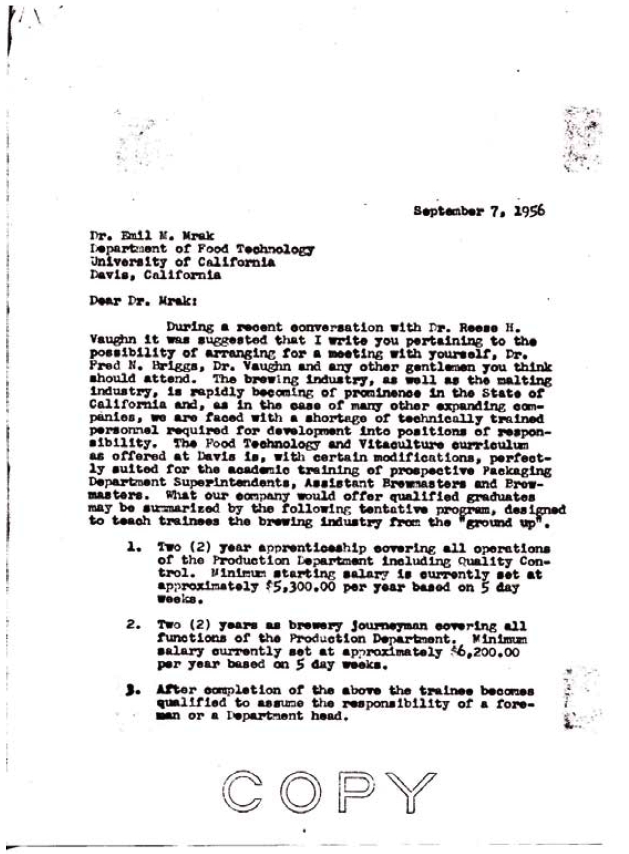 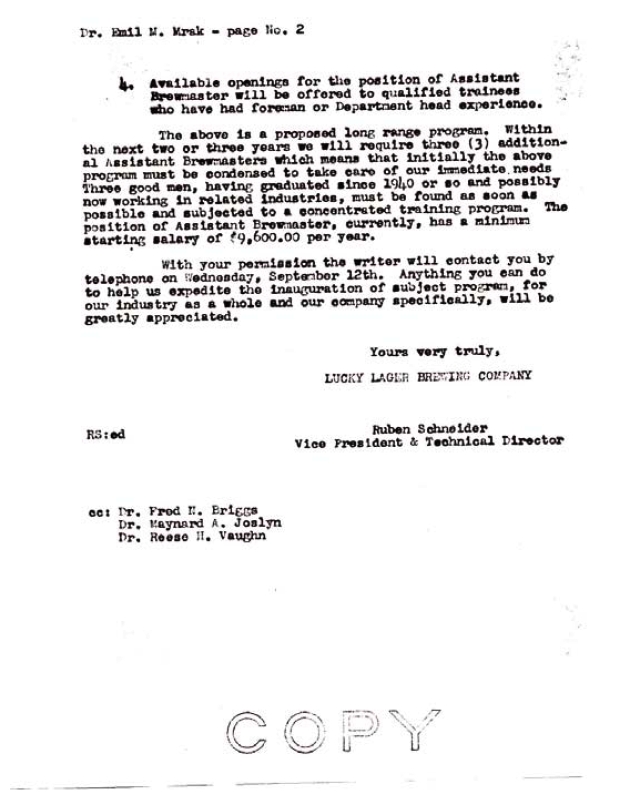 |
|
|
Following the repeal of prohibition brewing resumed as the main focus, under the directorship of F.P. Siebel Sr., the eldest son of J.E. Siebel. The company survives to this day.
Anton Schwarz (1839-1895) was born in Polna, Bohemia. He studied law at the University of Vienna before entering the Polytechnic Institute of Prague in 1858 to study under Balling. After working as a brewery consultant, he became manager of a brewery in Pest. He immigrated to New York in 1868 following the death of his wife.
Schwarz joined the staff of the American Brewer, before advancing to become its editor and proprietor. He was a passionate advocate of eliminating the less than wholesome practices then sometimes applied in brewing and championed the scientific training of brewers. He started courses of his own lectures on Long Island and in 1880 founded the ‘First Scientific Station for Brewing’, providing chemical and microbiological analysis. In 1882 he opened the US Brewers Academy.
Schwarz' American Brewer published numerous of his articles, all of them extremely practical and focused. Siebel and Schwarz both investigated use of adjuncts in brewing and may be credited with first advances towards lighter crisper, beers appreciated by Americans.
Early publications to address technical issues in brewing in the United States were:
An international brewer's congress was held in Chicago in 1893, in association with the World's Columbian Exposition. The Second International Brewer's Congress and the American Exposition of Brewing Machinery, Materials and Products was held in Chicago in 1911. Also there was the second International Barley and Hops Prize Exhibition and Educational Exhibition.
Several other laboratories were established, most notably the Wahl-Henius Institute by Dr Robert Wahl and Dr Max Henius in 1886 in Chicago. They opened the American Brewing Academy in 1887. The Dane Henius had been a favorite pupil of Emil Christian Hansen, while Wahl was an American who had studied with Henius in Marburg. The partners were the pioneers of pure yeast technology in the United States.
Dr Max Wallerstein founded the Wallerstein labs in New York in 1902.
The US Brewmasters Association was formed in Chicago on March 21st 1887. Its manifesto was ‘to make the interests of the brewing industry its own’. Previously there had been separate brewmaster societies, inter alia in New York, Cleveland and Cincinnati. The organization was incorporated in 1912 as the Master Brewers' Association of the United States, morphing to the Master Brewers Association of America (MBAA) in 1933.
The goals established for the US Brewmasters Association were ‘to cultivate mutual acquaintance; to further the interests of the brewing industry; to discuss technical questions relating to brewing; to promote the education of brewery workmen; and to establish a system of apprenticeship’. The President of the Chicago Brewer's Association declared at the first meeting ‘…we must take active steps to come to the aid of science, because where theory combines itself with practice, there we may be sure that gain to mankind will result’. The organization was to have its base in Chicago, and the business language was to be German.
By the time of the second convention in New York in 1888 there were 229 members and it was recommended that apprenticeships to the industry should be 2 years in duration and that any company with more than 15 workers should have one apprentice.
Ten years later there were 352 members and the expressed desire was that, following an apprenticeship, trainees should be directed to a brewers' college. At the 12th convention in Buffalo in 1900 it was declared that apprentices should be 16-20 years old, and should serve 2 years in a brewery and 3 months in a malt house. At this meeting addresses on scientific subjects were delivered by several brewing scientists. The organization periodically published the Brewers' Calendar, a reference book containing technical information.
It was not until 1948 that the MBAA created the MBAA Research Foundation in order to pursue and coordinate scientific research in brewing. They placed $50,000 in escrow to establish the capital sum. On January 13th 1950 there was a joint meeting in Chicago of the USBA, the Small Brewers Association (later called the Brewers Association of America) and a committee of the MBAA Research Foundation. The topic of debate was a plan for an industry-wide research program. After much discussion, there was a revocation of the MBAA Foundation to be replaced by a much broader Brewing Industries Research Institute, founded January 9th, 1952 and with charter members the American Society of Brewing Chemists, the Barley and Malt Institute, the Brewers Association of America, the USBA, and the MBAA. A later enrollee was the Dominion Brewers Association, which would become the Brewers Association of Canada.
A major problem concerned how to select projects and the issue of publishing the findings. This in turn led to financial pressures and on January 31st 1969 it was resolved to dissolve the Institute. All surviving assets passed to the MBAA. The parting contribution was a book edited by W.D. McFarlane, the Scientific Director of BIRI which summarized and explained the priorities for future research, wherever it may be undertaken. The overwhelming message concerned the need for much more study of beer stability, especially staling.
|
|
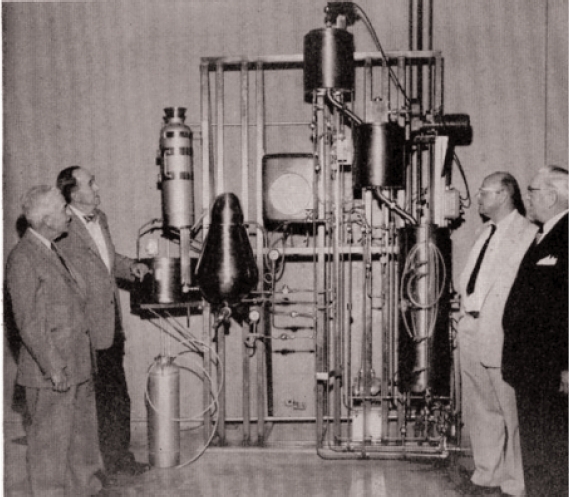 |
|
|
|
|
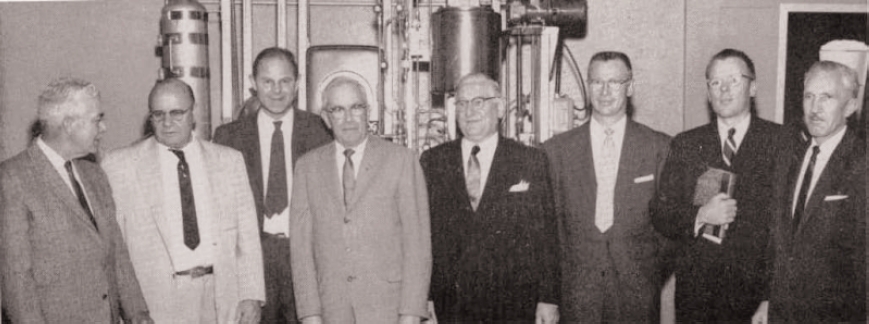 |
|
|
|
|
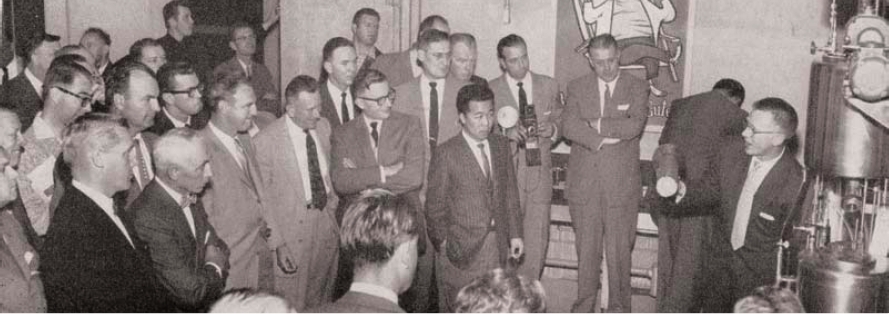 |
|
|
The pursuit of standardized methods for the US brewing industry commenced with the Analysis Committee of the USBA prior to prohibition. After repeal, the driving force for the restoration of activity in this area was Max Henius. In the fall of 1934 there was an initial meeting on the topic between the MBAA and USBA followed by a meeting at the Schwarz labs on October 12th of the same year at which it was agreed to have an initial focus on malt analysis. Six sub-committees were charged with the task of recommending different procedures. Inaugural funding was $250 each from brewers, maltsters and scientific stations [Table 1]. Soon the committee was considering methods beyond malt analysis and on October 11 1935 adopted the name American Society of Brewing Chemists (ASBC). The organization was headquartered at the Wahl-Henius Institute in Chicago and had 24 companies comprising its membership [Table 2].
| Key officers and represented companies after opening meeting of the ASBC | |
| Chairman | Max Henius (Wahl-Henius Institute) |
| Vice Chairman | John Hartung (Jacob Ruppert, Brewer) |
| Secretary | George Weschler (Weschler Malting Company) |
| Treasurer | Leo Wallerstein (Wallerstein Laboratories) |
| Malting Plants |
| Columbia Malting Company |
| Fleischmann Laboratories |
| Froedtert Grain and Malting Company |
| Kurth Malting Company |
| Rahr Malting Company |
| Albert Schwill & Co |
| Scientific Stations |
| The National Brewers Academy |
| Schwarz Laboratories, Inc |
| Siebel Institute of Technology |
| E.A. Siebel & Company |
| Wahl-Henius Institute |
| Wallerstein Laboratories |
| Breweries |
| Anheuser-Busch, Inc |
| Blatz Brewing Company |
| Premier-Pabst Corporation |
| Jacob Ruppert, Brewer |
| Schlitz Brewing Company |
| The founding members of the ASBC | ||
| Brewers | Maltsters | Scientific Stations |
| Anheuser-Busch | Columbia | National Brewers' Academy |
| Blatz | Fleischmann | Schwarz |
| Pabst | Froedtert | E.A. Siebel |
| Ruppert | Kurth | Siebel Institute |
| Schlitz | Rahr | Wahl-Henius Institute |
| Schaefer | Schwill | Wallerstein |
| Hop growers | Corn processors | |
| Clemens Horst | American Maize | |
| Pacific Hop Growers | Corn Products Refining Company | |
| Krause Milling | ||
| Patent Cereals | ||
Stroh was an alternate brewer member; Stephl was an alternate scientific station; Staley Products was an alternate corn processor.
It was soon proposed to throw ASBC open to individual membership with a mechanism for submitting research papers. At the meeting in Cleveland on June 17 1938 the by-laws were adopted establishing the structure of ASBC as it basically is today. The technical Committee was formed to continue the work on methods of analysis. Leo Wallerstein became chair of the membership committee, and within four months there were 31 members and 65 applications pending. The society was positioned to further scientific research in brewing, and the first meeting at which original research papers (thirteen in toto) were offered was in Kansas City, MO from May 22-24, 1939. The audience comprised 33 members (approximately one third of the total roll) and some of the papers were published in Cereal Chemistry (then, as now, there was a close association between ASBC and the American Association of Cereal Chemists, which publishes Cereal Chemistry). 1940 saw the first publication of the Proceedings of the American Society of Brewing Chemists, which became the Journal of the American Society of Brewing Chemists in 1976.
Liaison with the MBAA commenced in October 1945, with an initial focus on ‘The keeping qualities of beer’. By 1963 there was talk of a merger between ASBC and MBAA and the issue was put to the vote two years later, but did not pass. In 1977 a joint planning committee worked to arrange a scientific meeting encompassing both organizations, and as a result the first World Brewing Congress was held in St Louis, MO in September 1984.
A network of local groupings within the ASBC developed from initial gatherings in Cincinnati and Philadelphia in 1952. Local Sections were formally recognized in 1966, with New York being the first such assembly.
Publications at the time resided in offices of Raymond J. Tarleton in St Paul MN, Tarleton being the executive secretary of the AACC. The computerized membership systems have long catered well for not only ASBC and AACC but also the American Phytopathological Society and, now at the start of the 21st century, the MBAA.
It was in April 1880 that the Regents of the University of California were mandated by the California State legislature to establish a program of instruction and research in viticulture and enology, reflecting the clear potential for California to develop an international wine business. Upon the repeal of prohibition in 1935 the department became established on the campus at Davis.
In 1956 Ruben Schneider, Technical Director of San Francisco's Lucky Lager Brewing Company, wrote to Emil Mrak, then Chair of the Department of Food Technology at UC Davis (later Chancellor), urging the establishment of a brewing program to complement the wine focus [Fig. 1]. The generous remuneration available to brewery trainees that would emerge from such a program was remarkable. The brewing program was finally established in 1958 with a grant from the MBAA, Schneider now being its President. The brewing technology course was the first of its kind to be offered in a major American educational institution. The experimental brewery - ‘a miniature marvel of stainless steel and glass’ - was dedicated on December 8th 1958 [Figs. 2, 3, 4]. Some funding for the brewery came from the Frydenlund Brewing Company of Oslo, Norway. Furthermore, two $1,000 scholarships were awarded by the Wallerstein Company.
The brewing program came under the watchful eye of eminent fungal taxonomist Herman Phaff, who first taught any semblance of brewing at Davis, with some lectures as part of an Industrial Applications of Yeast course. Dr Donald Reynolds also taught some relevant classes. The first appointed teacher for brewing was T.O.M (‘Tommy’) Nakayama. From 1964 Michael Lewis took over the teaching of the brewing program. Charlie Bamforth was appointed to the Anheuser-Busch Professorship of Malting and Brewing Sciences in 1999.
Breeding and associated research program on hops have been prominent at Oregon State University (OSU, Corvallis) for a many years. Research on hops in the United States has been coordinated and funded through the member-based Hop Research Council since 1979. Since 1996, OSU has pursued a Fermentation Science teaching and research program. Fundamental attempts to develop improved malting barley varieties in the United States began in 1938 with the founding of the Malt Research Institute (MRI) in Madison, WI. The MRI coordinated the evaluation of barley varieties and funded research at the USDA-ARS Cereal Crops Research Unit at the University of Wisconsin. The Midwest Barley Improvement Association was formed in 1945 in Milwaukee, WI and in 1954 expanded to include the whole country, becoming the Malting Barley Improvement Association (MBIA). The MRI was merged with MBIA in 1959 and in turn the American Malting Barley Association (AMBA) emerged from these forerunners in 1982. This body supports fundamental and applied research through the awarding of grants.
A research program on brewing has been underway at Cornell since 1990.
Nowadays the in-house research effort pursued by production brewing companies is very limited. However, prominent programs have been pursued through the years by all the major players and, until relatively recently, a significant proportion of their research was published in the pages of the MBAA Technical Quarterly and the Journal of the ASBC. Competitive pressures nowadays dictate that these companies rarely publish original research findings, indeed the programs of brewing companies in the United States is now very much focused on competitive advantage. Amongst the most prominent developments emerging from the US brewing industry over the years has been the advent of low carbohydrate, superattenuated ‘light’ beers (the first having been Rheingold from Gablinger's in 1967) and the development of reduced hop bitter compounds for the prevention of ‘skunking’ in beers exposed to light.
|
Arnold, J.P. & Penman, F. (1933) History of the Brewing Industry and Brewing Science in America. Chicago: G.L.Peterson |
|
Baron, S. (1962) Brewed in America: A History of Beer and Ale in the United States. Boston: Little, Brown and Company |
|
Bud, R. (1993) The Uses of Life: A History of Biotechnology. Cambridge: Cambridge University Press |
|
McFarlane, W.D. (1970) Industry-Sponsored Research on Brewing: Needs and Priorities. Chicago: Brewing Industries Research Institute |
|
Schwarz, A. (1995) ‘Translation of the Report of the First National Convention of the United States Brewmasters Association’. Tech. Quart. Mast. Brew. Assoc. Amer., 32, 115-117 |
|
Tenney, R.I. & Dakin, P.E. (1984) ‘History of the American Society of Brewing Chemists’. J. Am. Soc. Brew. Chem., 42, 98-101 |